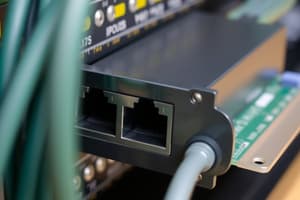Podcast
Questions and Answers
What is the main difference between IPv4 and IPv6?
What is the main difference between IPv4 and IPv6?
- IPv4 has a limited address space, while IPv6 was created to accommodate the growing number of internet-connected devices. (correct)
- IPv4 is a 64-bit address while IPv6 is a 128-bit address.
- IPv4 uses hexadecimal characters while IPv6 uses decimal numbers.
- IPv4 is composed of eight groups of four octets, whereas IPv6 is made up of four octets.
Which of the following is NOT considered a common threat in cybersecurity?
Which of the following is NOT considered a common threat in cybersecurity?
- Ransomware
- Malware
- Phishing
- Spam (correct)
What technology is primarily used for high-speed, next-generation cellular networks?
What technology is primarily used for high-speed, next-generation cellular networks?
- Bluetooth 5.0
- 5G (correct)
- 4G LTE
- Wi-Fi 6
Which security measure is specifically designed to prevent unauthorized access to a network?
Which security measure is specifically designed to prevent unauthorized access to a network?
What role does Artificial Intelligence play in networking?
What role does Artificial Intelligence play in networking?
What is the primary purpose of a computer network?
What is the primary purpose of a computer network?
Which type of network typically connects devices within a single building?
Which type of network typically connects devices within a single building?
What role does a router serve in a computer network?
What role does a router serve in a computer network?
Which of the following best describes a Wide Area Network (WAN)?
Which of the following best describes a Wide Area Network (WAN)?
What is the function of the Transmission Control Protocol (TCP)?
What is the function of the Transmission Control Protocol (TCP)?
What is a unique identifier assigned to each device on a network called?
What is a unique identifier assigned to each device on a network called?
Which protocol is commonly used for transferring files over the internet?
Which protocol is commonly used for transferring files over the internet?
What is an example of a Wireless Network?
What is an example of a Wireless Network?
Flashcards
What is a computer network?
What is a computer network?
A group of interconnected computers and devices that share resources and data.
What are Local Area Networks (LANs)?
What are Local Area Networks (LANs)?
Networks that connect computers within a small area like an office.
What are Wide Area Networks (WANs)?
What are Wide Area Networks (WANs)?
Networks that connect computers over a large geographic area, like cities or countries.
What is a router?
What is a router?
Signup and view all the flashcards
What is an IP address?
What is an IP address?
Signup and view all the flashcards
What is the internet?
What is the internet?
Signup and view all the flashcards
What is the Transmission Control Protocol (TCP)?
What is the Transmission Control Protocol (TCP)?
Signup and view all the flashcards
What is the Hypertext Transfer Protocol (HTTP/HTTPS)?
What is the Hypertext Transfer Protocol (HTTP/HTTPS)?
Signup and view all the flashcards
What is DNS?
What is DNS?
Signup and view all the flashcards
What is IPv4?
What is IPv4?
Signup and view all the flashcards
What is IPv6?
What is IPv6?
Signup and view all the flashcards
What is the World Wide Web (WWW)?
What is the World Wide Web (WWW)?
Signup and view all the flashcards
What is Malware?
What is Malware?
Signup and view all the flashcards
Study Notes
Computer Networks
- A computer network is a group of interconnected computers and devices that communicate to share resources and data.
- Purpose: Facilitate data exchange and communication, enable resource sharing (e.g., printers, files, internet).
- Examples:
- Local Area Network (LAN): Within a single building.
- Wide Area Network (WAN): Across large areas (cities, countries).
- Metropolitan Area Network (MAN): Covers a city or campus area.
Types of Computer Networks
- Local Area Network (LAN): Connects computers within a small area, like an office, typically private.
- Metropolitan Area Network (MAN): Connects networks within a city, often used by businesses or government.
- Wide Area Network (WAN): Covers a large geographic area, using leased telecom lines; the internet is the largest WAN.
- Wireless Networks: Include Wi-Fi and Bluetooth; essential for mobile connectivity.
Networking Devices
- Router: Directs data between networks, enabling internet access.
- Switch: Connects devices within a network; filters data to the correct destination.
- Modem: Converts digital data for transmission over phone lines.
- Access Point: Provides wireless connectivity within a network.
- Firewall: Security device that controls network traffic to prevent unauthorized access.
Introduction to the Internet
- Internet Definition: A vast network connecting millions of private, public, academic, and business networks globally.
- Brief History: Originated from ARPANET in the 1960s; became commercialized in the 1990s.
- How It Works: Data is broken into packets, transmitted over networks, and reassembled on arrival.
Internet Protocols
- Internet Protocol (IP): Manages addressing and routing of packets across networks.
- Transmission Control Protocol (TCP): Ensures reliable delivery of packets.
- Hypertext Transfer Protocol (HTTP/HTTPS): Governs web communication and security (HTTPS).
- File Transfer Protocol (FTP): Used for transferring files over the internet.
- Email Protocols (SMTP, POP3, IMAP): Manage sending and receiving email.
IP Addresses and Domain Names
- IP Address: A unique identifier assigned to each device on a network (e.g., 192.168.1.1).
- Domain Name System (DNS): Translates human-friendly domain names into IP addresses.
- IPv4: 32-bit address, limited in availability; Example: 192.168.0.1
- IPv6: 128-bit address, created to handle the expansion of internet-connected devices; Example: 2001:0db8:85a3:0000:0000:8a2e:0370:7334
Internet Services and Applications
- World Wide Web (WWW): A collection of websites and web pages accessible via the internet.
- Email: Digital communication through electronic mail services.
- Cloud Computing: Accessing and storing data online rather than locally.
- Social Media and Streaming Services: Platforms for interaction, entertainment, and sharing content.
Cybersecurity in Networking
- Importance of Network Security: Protects data and resources from cyber threats.
- Common Threats:
- Malware: Malicious software designed to damage or exploit devices.
- Phishing: Fraudulent attempts to gather sensitive information.
- Ransomware: Malware that encrypts data, demanding a ransom.
- DDoS: Overloads servers with traffic, causing a shutdown.
- Security Measures: Use of firewalls, antivirus software, encryption, and two-factor authentication (2FA).
Future Trends in Networking and the Internet
- 5G and Beyond: Next-generation cellular networks enabling faster data transmission.
- Internet of Things (IoT): Network connectivity extending to everyday objects, allowing data exchange.
- Artificial Intelligence in Networking: Al improves network efficiency, security, and troubleshooting.
- Quantum Networking: Future technology for highly secure communication using quantum mechanics.
Studying That Suits You
Use AI to generate personalized quizzes and flashcards to suit your learning preferences.



